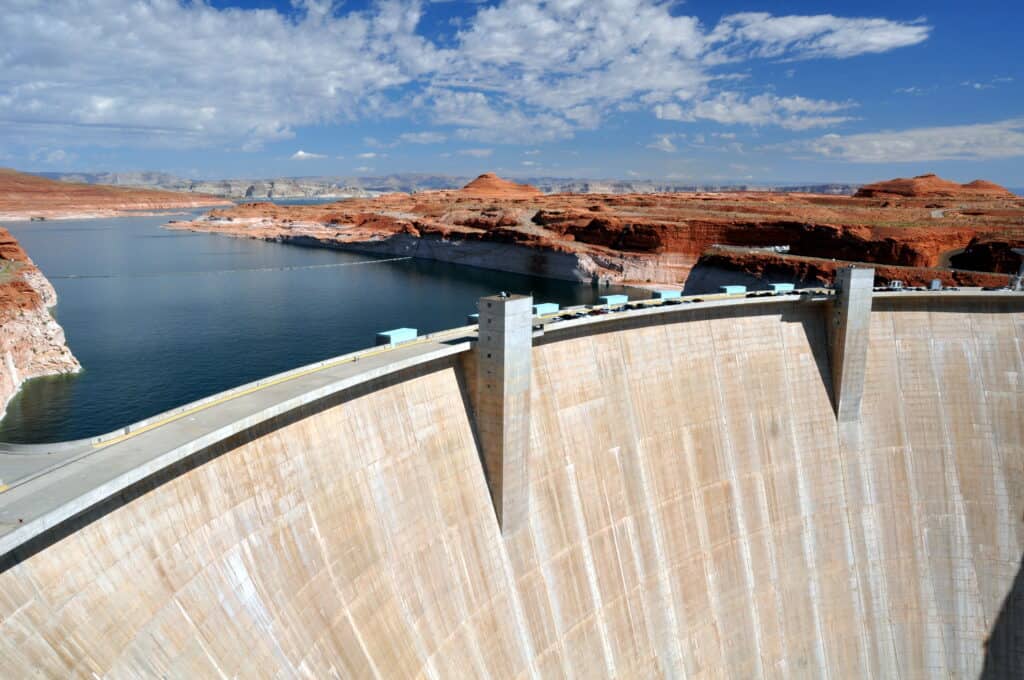Most people don’t know that Nevada is home to an underwater ghost town. While it’s true that Nevada is full of Wild West ghost towns, most of them were from the glory days of gold mining and westward expansion.
However, St. Thomas is a ghost town unlike any other. In fact, St. Thomas has often been referred to as the “underwater ghost town.” According to the National Park Service, the water level in Lake Mead has caused it to appear and disappear over the years.
So what is it about this ghost town that makes it so spooky? Discover how Lake Mead led to the disappearance of St. Thomas and its transformation into a ghost town.
History of St. Thomas
The Founding of St. Thomas

St. Thomas, Nevada, was originally settled in 1865 by Mormons.
©Amanda Mohler/Shutterstock.com
In 1865, Mormon settlers established St. Thomas, Nevada. As a thriving Mormon settlement, St. Thomas boasted farms, a school, a hotel, a grocery store, a post office, an ice cream shop, and a hotel. The town eventually had a population of about 500. The residents in St. Thomas were captivated by their simple lifestyle in spite of the lack of indoor plumbing and electricity. Sadly, they couldn’t keep the magic of their simple lives going on for long.
Change loomed on the horizon, which would be introduced by then-President Calvin Coolidge.
Construction of the Hoover Dam Floods the Town

About 60 feet of water covered St. Thomas at its highest point.
©K Hannon/Shutterstock.com
The existence of St. Thomas shortly came to an end after President Calvin Coolidge decided to make a damning decision. In 1928, President Calvin Coolidge authorized the construction of the Hoover Dam, originally called the Boulder Dam. St. Thomas then ceased to exist.
According to the website of the National Park Service (NPS), St. Thomas, the dam created Lake Mead, which flooded areas along the Muddy and Virgin rivers. During the early 1930s, Lake Mead began to form, and St. Thomas gradually disappeared under the rising waters.
Residents of St. Thomas fled their town because of rising water levels. In 1938, Hugh Lord, the town’s last resident, paddled away from his home when it was flooded by the river. About 60 feet of water covered St. Thomas at its highest point. Lake Mead flooded many other settlements, like Calville and nearby Anasazi Indian sites.

The Hoover Dam caused the town of St. Thomas, Nevada to be flooded.
©Matej Hudovernik/Shutterstock.com
It’s Not the First Time the Town Got Flooded
Oddly enough, the formation of Lake Mead wasn’t the first time the town had been flooded.
Researchers have discovered that ancient peoples from the Basket-Maker and Pueblo cultures were cultivating maize, beans, and other crops on the territory for more than a thousand years. In the past, the native community here, also known as Pueblo Grande de Nevada, or the Lost City, was also flooded. In the 1930s, archaeologists discovered a large number of artifacts that helped them understand the original native inhabitants.
As the years went by, the water level of Lake Mead fluctuated. There have been several reemergences of the ghost town, including the reemergences of 1945, 1963, and 2012. Nevada is currently experiencing such severe drought conditions that the St. Thomas ghost town has remained above water since 2012.
The St. Thomas Ghost Town Has Reemerged As A Tourist Destination

After Lake Mead was filled, the foundation of St. Thomas School House sat underwater for many years.
©iStock.com/Sean Pavone
We noted that the St. Thomas ghost town has emerged from the murky depths multiple times. Lake Mead’s water level is historically low at the moment. Since 2002, the town has been exposed due to prolonged, severe drought in the area.
Nowadays, visitors can explore the ruins of the St. Thomas ghost town and all of the interesting things it has to offer. When you walk through the area, the first thing you’ll notice is how cracked the earth appears. Along the way, you’ll also see the foundations of old buildings that once stood proudly. One of these foundations includes the St. Thomas School House. You can also see federally protected artifacts as well.
The abandoned ghost town is located in the Lake Mead National Recreation Area, about sixty miles from Las Vegas and seven miles from Overton. It is also possible to make a day trip from Las Vegas to St. Thomas to get the most out of visiting Lake Mead. You can easily access the town by a three-mile dirt road. Visitors are invited to discover and explore this fascinating town that was once booming before becoming deserted.

An ancient Pueblo community like this one was flooded before Lake Mead ever existed.
©Nick Fox/Shutterstock.com
Visit The Lost City of The Ancestral Pueblos
Aside from the St. Thomas ghost town, while you’re in the area, you also won’t want to miss out on exploring The Lost City of the Ancestral Pueblos. As we mentioned earlier, the area was once inhabited by many native tribes. In fact, Native Americans began migrating to the area that would become Lake Mead more than 1,000 years ago. Southern Nevada’s Moapa Valley was home to a thriving native culture.
Archaeologists were able to uncover tools, weapons, food, and even skeletal remains. This gave us insight into an important part of Native American history. According to archaeologists studying the ruins, the Pueblo was only one of many Native American groups living in the lower Moapa Valley, where Pueblo Grande de Nevada is located.
Based on archaeological findings, Basketmakers lived in the area first. Their intricate and extensive use of basketry earned them the name Basketmakers. Over time, the Pueblo people moved into the area. It is likely that Basketmakers and Pueblo lived alongside each other, combining their ways of life.
There are ceramics, shells, jewelry, and impressive baskets on display at the Lost City Museum. In addition to being only about 70 miles northeast of the Las Vegas Strip, the Lost City Museum is only a short distance from Valley of Fire State Park and Lake Mead National Recreation Area.

You may see a slow-moving desert
tortoise
on a visit to the Ghost Town of St. Thomas.
©Darren J. Bradley/Shutterstock.com
Animals that Live Around the Ghost Town of St. Thomas
Visitors with a keen eye will notice a variety of illusive wildlife on a visit to the St. Thomas ghost town. Desert tortoises, iguanas, Gila monsters, and rattlesnakes may be observed creeping around in the desert. In the sky, tourists may observe bald eagles, Peregrine falcons, and owls. Desert bighorn sheep can be seen making their way along the cliffs of the surrounding hills. 19 different species of bats can be found in the area – as well as the occasional mountain lion.
Up Next…Discover More About Lake Mead!
- Lake Mead Is 169 Feet Below Normal, Revealing Bodies, Boats, and More. What’s Next?: Discover what lurks under Lake Mead’s fluctuating depths!
- Shocking Images from Space Show How Much Lake Mead is Vanishing: The views from space will astonish you. Why is Lake Mead vanishing?
- This Is Why It Takes 4 Hours to Launch A Boat On Lake Mead: Is it more trouble than it’s worth? No, and find out why.
The photo featured at the top of this post is © K Hannon/Shutterstock.com
Thank you for reading! Have some feedback for us? Contact the AZ Animals editorial team.






